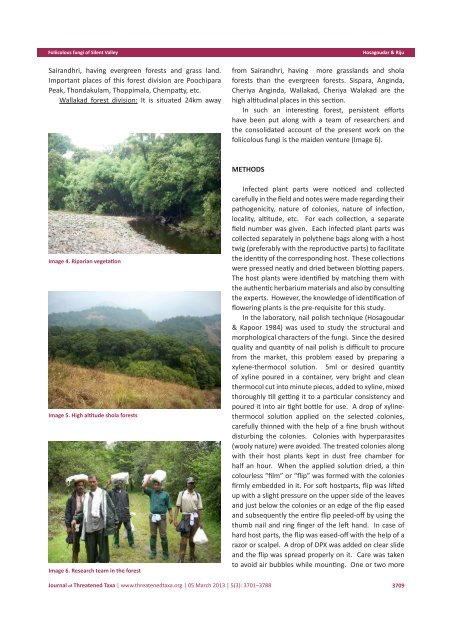Foliicolous fungi <strong>of</strong> Silent Valleyforests in 1914 as per notification number 291 dated18 May 1914 and published in St. George Gazettedated 9 June 1914. During the course <strong>of</strong> reservation,a portion <strong>of</strong> land lying west <strong>of</strong> Kunthipuzha in surveynumber 235 <strong>of</strong> Kundamangalam and survey number 51<strong>of</strong> Payyandadumdesoms (village) <strong>of</strong> Walluvanad Talukaggregating 785.75 acre was acquired. Till 1921, SilentValley was part <strong>of</strong> South Malabar Division with headquarters at Nilambur. During 1921, it came under theadministrative control <strong>of</strong> Palghat Forest Division.Proposed as National Park: The first idea <strong>of</strong> thehydroelectric project came in the year <strong>of</strong> 1921. However,Government <strong>of</strong> Kerala declared the Silent Valley Reserveas a National Park as per GO. 5462 FSA/3/82 dated15 November 1984 under the provision <strong>of</strong> wildlife(protection) act, 1972. In 1985, 7 September, the PrimeMinister Rajiv Gandhi inaugurated the Silent ValleyNational Park. The entire area <strong>of</strong> Silent valley nationalpark was made as a part <strong>of</strong> the area <strong>of</strong> the NilgiriBiosphere reserve during the year 1986.Review <strong>of</strong> research work in Silent Valley: Silent Valleyis originated approximately 5 crore years ago. Therewas no detailed study till the first two decades <strong>of</strong> 19 thcentury. Since 1840, Robert White, Beddome, Gambleand several others have studied the plant wealth <strong>of</strong> thisarea. In 1860, T.C. Jerdon discovered an orchid, MalabarDaffodil Ipsea malabarica, which remained unknownfor 120 years. During the period <strong>of</strong> 1981–1985, Manilal(1988) and Vajravelu (1990) have studied the plantwealth <strong>of</strong> Silent Valley and reported the diversity <strong>of</strong>flowering and non flowering plants. 1979–80, ZoologicalSurvey <strong>of</strong> India described 20 new species from SilentValley including new frog species, Alsonia rubijina andMicrasalus thambi. Bhat (2010) has enumerated fungifrom this region. Hosagoudar (1985, 1996, 2006a, b, c,Hosagoudar & Riju2007, 2008, 2010), Hosagoudar & Archana (2009a, b),Hosagoudar & Biju (2005, 2006), Hosagoudar & Prabha(2009), Hosagoudar & Riju (2011a,b) and Hosagoudar etal. (1996, 2009, 2010, 2011) have contributed towardsthe foliicolous fungi <strong>of</strong> this region. Mohanan (2003, 2011)has studied several macr<strong>of</strong>ungi including mycorrhizalfungi <strong>of</strong> commercially timber yielding plants in KeralaState but as such there is no study in the compact forestlike Silent valley. Hence, the present study has got muchimportance.Forest types <strong>of</strong> Silent Valley: Forests are the complexnatural ecosystems, form the factory <strong>of</strong> water recyclingand climatic variation. On the basis <strong>of</strong> ecologicalcharacteristics, the forests are classified into four types:Upland region, Riparian region, Slopes and Submersiblearea. Based on the vegetation, we come across fourtypes <strong>of</strong> forests, namely, moist evergreen forests,dry evergreen forests, high land grass land, low landgrassland and high altitude sholas (Images 2–5).Forest Divisions: Silent Valley National Park hasfour forest divisions, namely, Sairandhri, Neelikallu,Poochipara and Wallakad. Each forest division hasevergreen forests, grass lands and shola forests.Sairandhri forest division: This is a tourist zone,located 23km away from Mukkali in Palghat District,dominated with evergreen forests. This divisioncomprises the following major forest localities, namely,Aruvupara, Katyawaramudi, Punnamala, Parathode, etc.Neelikallu forest division: Located 10km awayfrom Sairandhri, partially surrounded by Kunthipuzha,comprises grasslands, evergreen and semievergreenforests at higher elevations. Important places <strong>of</strong> thisdivision are Neelikallu, Ambalappara, Vannampara,Pulippara, Chempatty, etc.Poochipara forest division: It is 8km away fromImage 2. A view <strong>of</strong> evergreen forestImage 3. Floating clouds on evergreen forests3708<strong>Journal</strong> <strong>of</strong> <strong>Threatened</strong> <strong>Taxa</strong> | www.threatenedtaxa.org | 05 March 2013 | 5(3): 3701–3788
Foliicolous fungi <strong>of</strong> Silent ValleySairandhri, having evergreen forests and grass land.Important places <strong>of</strong> this forest division are PoochiparaPeak, Thondakulam, Thoppimala, Chempatty, etc.Wallakad forest division: It is situated 24km awayHosagoudar & Rijufrom Sairandhri, having more grasslands and sholaforests than the evergreen forests. Sispara, Anginda,Cheriya Anginda, Wallakad, Cheriya Walakad are thehigh altitudinal places in this section.In such an interesting forest, persistent effortshave been put along with a team <strong>of</strong> researchers andthe consolidated account <strong>of</strong> the present work on thefoliicolous fungi is the maiden venture (Image 6).METHODSImage 4. Riparian vegetationImage 5. High altitude shola forestsImage 6. Research team in the forestInfected plant parts were noticed and collectedcarefully in the field and notes were made regarding theirpathogenicity, nature <strong>of</strong> colonies, nature <strong>of</strong> infection,locality, altitude, etc. For each collection, a separatefield number was given. Each infected plant parts wascollected separately in polythene bags along with a hosttwig (preferably with the reproductive parts) to facilitatethe identity <strong>of</strong> the corresponding host. These collectionswere pressed neatly and dried between blotting papers.The host plants were identified by matching them withthe authentic herbarium materials and also by consultingthe experts. However, the knowledge <strong>of</strong> identification <strong>of</strong>flowering plants is the pre-requisite for this study.In the laboratory, nail polish technique (Hosagoudar& Kapoor 1984) was used to study the structural andmorphological characters <strong>of</strong> the fungi. Since the desiredquality and quantity <strong>of</strong> nail polish is difficult to procurefrom the market, this problem eased by preparing axylene-thermocol solution. 5ml or desired quantity<strong>of</strong> xyline poured in a container, very bright and cleanthermocol cut into minute pieces, added to xyline, mixedthoroughly till getting it to a particular consistency andpoured it into air tight bottle for use. A drop <strong>of</strong> xylinethermocolsolution applied on the selected colonies,carefully thinned with the help <strong>of</strong> a fine brush withoutdisturbing the colonies. Colonies with hyperparasites(wooly nature) were avoided. The treated colonies alongwith their host plants kept in dust free chamber forhalf an hour. When the applied solution dried, a thincolourless “film” or “flip” was formed with the coloniesfirmly embedded in it. For s<strong>of</strong>t hostparts, flip was liftedup with a slight pressure on the upper side <strong>of</strong> the leavesand just below the colonies or an edge <strong>of</strong> the flip easedand subsequently the entire flip peeled-<strong>of</strong>f by using thethumb nail and ring finger <strong>of</strong> the left hand. In case <strong>of</strong>hard host parts, the flip was eased-<strong>of</strong>f with the help <strong>of</strong> arazor or scalpel. A drop <strong>of</strong> DPX was added on clear slideand the flip was spread properly on it. Care was takento avoid air bubbles while mounting. One or two more<strong>Journal</strong> <strong>of</strong> <strong>Threatened</strong> <strong>Taxa</strong> | www.threatenedtaxa.org | 05 March 2013 | 5(3): 3701–37883709

















